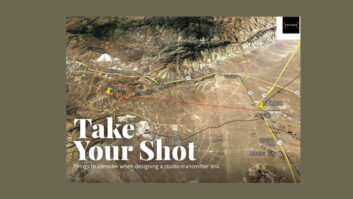Entercom Buffalo Rebuilds: Building Today for a Digital Tomorrow
Jan 1, 2001 12:00 PM, By Chriss Scherer, editor
Efficiency in facility consolidation
Any facility construction project requires time and personnel to do the job right. In many instances, stations try to plan and build new facilities and still maintain the existing facilities without any additional manpower. Typically, when this is done, something suffers. Either the new facilities fall behind schedule or the present facilities fall apart. Hiring additional help during a major project is a wise investment.
When Entercom Buffalo decided to consolidate its six stations into one facility, the decision to hire a system integrator was made early. Over the course of the project, the decision proved to be perfect. When plans for the move began, the stations were owned by Sinclair. A change of ownership during a project can bring its own concerns, but the Buffalo project continued forward. Even with two format and call-letter changes, the project stayed on course.
The biggest advantage to hiring a system integrator is that a considerable amount of work can be done off site even before the studio building is ready. In this case, the work on the studios in Buffalo began in Cincinnati at Harris Broadcast. This type of off-site work is common for most system integrators. It allows an installation to be almost completely turnkey by having a nearly completed studio delivered to the new facility. During the studio construction, Harris personnel completed the new installation work while the Entercom staff maintained the existing facilities.
Getting started
The six Buffalo stations � WKSE-FM, WTSS-FM, WGR-AM, WBEN-AM, WWKB-AM and WWWS-AM � occupied four locations around Buffalo before the move. Like most consolidations, the expense of operating multiple locations was not cost effective. Also, some of the studio facilities were far from modern in appearance and function. The initial plans to move began in 1995. A suitable facility was not found until July 1999.
While the location search progressed, the equipment choices were made being made. The stations knew they wanted digital consoles and an on-air audio delivery system that would be fully integrated into their new operations. Not every new facility is designed to be completely digital from end to end. Each project will have unique requirements, and the appropriate solution may be provided by analog or digital equipment. The final choices for the heart of the operation were made with Auditronics NuStar consoles, SAS routing switchers and a Dalet audio delivery system.
The entire facility occupies 35,000 square feet, which is most of one floor in the two-story building. An additional 2,500 square feet is being used by another building tenant. The building has only two stories, so the STL antennas are mounted on a neighboring office building. Copper wiring and fiber optic cable have been run between the studio and nearby rooftop through a 2,000-foot trench. The STL transmitters have a touch-tone remote control.
At the center of the operation is Tech Core. The room houses 22 racks and is also the central distribution point for the facility. Each studio is connected to this center with 12-pair Gepco AES-3 audio cable and Belden DataTwist CAT5 cable. The CAT5 cable is used for all the logic wiring and for handling Ethernet signals. While not every audio source in the facility is digital, the AES-3 cable is excellent analog audio cable. AES-3 cable also provides a constant electrical characteristic; something that is not always the case with analog wiring. Each studio also has six coaxial cables run to it for future use.
All the wiring is terminated on ADC Icon (I-24 and I-96) blocks with IWS frames. The inter-room wiring was completed off-site and delivered in Buffalo ready for installation. Once delivered, the cables were run in cable trays, and the studio terminations were completed. In all, the entire facility has more than 7.5 miles of wire and cable.
The on-air delivery system was chosen in 1995. At that time, the choices for a system that integrated newsroom and on-air functions were limited, and Dalet made the final cut. The stations wanted an integrated system to avoid file conversions and distribution between different systems. It is based on a WindowsNT network and has 31 workstations, including those in news. It is capable of up to 450 hours of storage using LayerII compression in a RAID5 array. The playback-only PCs use Digigram PCX-80 cards, and the recording PCs use Digigram PCX-11+ cards.
Audio routing and intercom functions are handled by an SAS 64000 and 32000, respectively. D/A conversions are made by the SAS 256 � 256 router as needed. The 32000 serves as a facility intercom, but it also provides IFB feeds for remotes.
There are five control rooms in all. The sixth station is automated, so it does not require a dedicated control room. The air studios are similar in design but are tailored for the use of each individual station. There are six production rooms that are all identical. This allows producers to move easily between studios without having to adapt to a different setting each time a new studio is used.
There are four talk studios. Three of them are dedicated to single control rooms for WGR, WBEN and WWKB. The fourth is available for overflow needs and is used for public affairs program preparation. To complete the studio compliment, there are two small booths used for voice-overs and news announce booths. These can be routed to any control room or production room and are used regularly for daily newscasts. News is prepared in the 10-workstation newsroom.
While the Entercom Buffalo facility is not completely digital, it is ready for a smooth transition when that day comes. Selecting equipment that can serve a facility’s analog needs today and its digital needs tomorrow is a valuable step in preparing a station for continued success.
Thanks to Paul Barzizza, manager, systems engineering, Joe Perez, systems engineer, and Ken Dillard, systems engineer, of Harris, and Tom Atkins, director of engineering, Entercom Buffalo, for their assistance in preparing this feature. Photos by Tom Atkins.
Building from a scale model
The inter- and intra-studio wiring was begun in Harris’ Cincinnati facility. When wire and cable is being run, there is no room for error. Making cables that are too short can cause significant delays later on. To avoid this problem, the studio plans were laid out in life-size proportions first.
Masking tape was placed around the floor of the high-bay room to indicate walls. The studio furniture and racks were brought in and put in place. Then, the wire and cable assemblies were measured, run and terminated on one end. By creating the exact facility dimensions off site, and without the limitations or real walls and ceilings, the wire and cable assemblies were constructed in less time, and each was made exactly to the proper length.
Project timeline
- � 1995
- Decision made to consolidate all facilities
- � July 1999
- papers signed for new location
- � August 1999
- general contractor work began
- � December 1999
- stations’ ownership transferred from Sinclair to Entercom
- � January 9, 2000
- Harris arrives onsite and begins 90-day install period
- � January 10, 2000
- general administration offices move from two buildings into one.
- � February 2000
- WTSS moved into new facility
- � March 2000
- WBEN and WWWS move
- � April 2000
- WKSE, WGR, WWKB move
For more photos and a facility equipment list, go to www.beradio.com and click on Spotlight.












